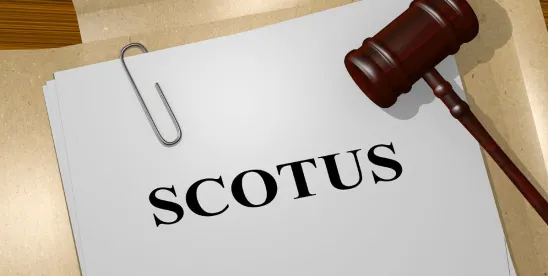On May 16—for the second time in two weeks—the U.S. Supreme Court, this time unanimously, has taken a lenient, plaintiff-friendly view of whether a filing deadline is jurisdictional in the sense that it is governed by the occurrence of a triggering event or its discovery. In Harrow v. Department of Defense, the Court, per Justice Kagan, held that the 60-day appeal provision regarding a federal Merit Systems Protection Board (the “Board”) decision is not jurisdictional and is subject to equitable exceptions, such as waiver, forfeiture, and equitable tolling. Stuart Harrow appealed to the Board a Department of Defense action furloughing him for six days. The Board took five years to decide the case against Mr. Harrow, but he didn’t learn of the decision until the 60-day appeal period had expired.
Reversing the Federal Circuit, the Court held that the relevant provision, 5 U.S.C. §7703(b)(1), is not jurisdictional. Although such deadlines are often phrased in mandatory terms, they are generally subject to exceptions, but when Congress enacts a “jurisdictional” requirement, it “mark[s] the bounds” of a court’s power, and a litigant’s failure to follow the rule “deprives a court of all authority to hear a case,” with no exceptions. See Boechler v. Commissioner, 596 U. S. 199, 203 (2022). Accordingly, the Court will “treat a procedural requirement as jurisdictional only if Congress ‘clearly states’ that it is.” Ibid. Under that approach, “most time bars are nonjurisdictional,” even when “framed in mandatory” and “emphatic” terms. See United States v. Kwai Fun Wong, 575 U. S. 402, 410–411 (2015). “No language in the provision Harrow violated suggests a different result. Section 7703(b)(1) states that an appeal ‘shall be filed within 60 days after the Board issues notice of the final order.’ Although the deadline is stated in mandatory terms, this fact is ‘of no consequence. . . .’ ‘What matters instead’ is whether the time bar speaks to the court’s jurisdiction.’”
In assessing the Court’s leanings with respect to filing deadlines, recall last week’s decision in Warner Chappell Music, Inc. v. Nealy. There, in another opinion written by Justice Kagan, the Court considered whether the three-year deadline for filing an infringement claim under the Copyright Act is triggered by occurrence or discovery. The Court took the case “on the assumption that such claims may be timely under the Act’s limitations provision.” Noting that “the Copyright Act contains no separate time-based limit on monetary recovery,” the Court held open the possibility that the plaintiff might obtain damages, albeit his discovery of alleged infringements that occurred more than three years before he became aware of them.
Both these cases suggest the Court’s amenability to taking plaintiff-friendly positions where the facts reasonably explain the ostensible delay. They continue a trend in that direction enunciated in the Boechler and Kwai Fun Wong cases, cited above. The collection of these cases also shows that Justice Kagan is the usual spokesperson for the Court on the issue.
Smith v. Spizzirri is a case of particular importance to many of the readers of this blog who practice on the defense side of employment and consumer-facing cases. The underlying case is a typical employment dispute. A group of present and former drivers for an on-demand delivery service sued their employer in an Arizona court, claiming that they had been misclassified as independent contractors and were deprived of minimum and overtime wages and benefits. Their employer removed the case to federal court and moved to compel arbitration and for dismissal of the lawsuit. The employees agreed that the dispute was arbitrable but that the court proceeding should be stayed, not dismissed. Continuing the trend of the Court’s decisions that give primacy to the Federal Arbitration Act (FAA) in determining the appropriate forum for disputes governed by arbitration agreements, a unanimous court, per Justice Sotomayor, held that “[w[hen a district court finds that a lawsuit involves an arbitrable dispute and a party has requested a stay of the court proceeding pending arbitration, §3 [of the FAA] compels the court to issue a stay, and the court lacks discretion to dismiss the suit.” However, the Justices might have divided in other cases concerning text, all the Justices agreed that statutory text, structure, and purpose of §3 all point to this conclusion. The statute’s use of “shall” “creates an obligation impervious to judicial discretion.” That term is to be applied generously, as the structure of the statute envisions the possibility of the parties returning to a court if the arbitration is inconclusive. Thus, dismissal, rather than a stay, is not an option. If a district court could dismiss a suit subject to arbitration even when a party requests a stay, that dismissal would trigger the right to an immediate appeal where Congress otherwise has sought to forbid one.
Finally, in Consumer Financial Protection Bureau v. Community Financial Services Assn. of America, Ltd, the Court upheld the authority of Congress under the Constitution’s Appropriations Clause, Art. I, §9, cl. 7, to authorize the Bureau to draw money from the earnings of the Federal Reserve System to finance its activities. The case produced an interesting array of justices, with Justice Thomas writing for a 7–2 majority that included the Chief Justice and Justices Sotomayor, Kagan, Kavanaugh, Barrett, and Jackson. A concurring opinion, filed by Justice Kagan, was joined by Justices Sotomayor, Kavanaugh, and Barrett; Justice Jackson also separately concurred; and Justice Alito and Gorsuch dissented. So much for ideological stereotypes. The majority held that the Bureau’s funding mechanism constitutes an “Appropriatio[n] made by Law.” “Based on the Constitution’s text, the history against which that text was enacted, and congressional practice immediately following ratification, we conclude that appropriations need only identify a source of public funds and authorize the expenditure of those funds for designated purposes to satisfy the Appropriations Clause.”
As a chapter in the interpretive debate among the Justices, in which “original meaning” has become a predominant tool for defining the limits of judicial authority, both the majority and the two dissenters argue conflicting Originalist positions. While the dissenters agree that the question, in this case, is ultimately about the meaning of “Appropriations,” they fault the majority for consulting dictionaries to ascertain the original public meaning of that word, insisting instead, contrary to Originalist tenets, that “Appropriations” is an evolving “term of art whose meaning has been fleshed out by centuries of history.” In something of a jab at two justices with whom he usually is in agreement, Justice Thomas writes that “we have explained at length, both preratification and postratification appropriations practice support our source-and-purpose understanding. . . . What is more, the dissent never offers a competing understanding of what the word “Appropriations” means. Touché.
In one sense, these dueling historical analyses echo Justice Kagan’s concession that “We are all originalists” now. In another, the case perhaps suggests the location of the outer boundary of recent Court cases dealing with issues of congressional delegation under the Major Questions Doctrine and other tenets of deference to administrative agencies. A quickly quashed rumor circulated that the Court had decided the Loper case concerning whether the Chevron Doctrine should be abandoned or limited. That rumor was false—the Court has yet to decide that case. But maybe it has given us a hint that where a congressional statute clearly and specifically grants authority to a federal agency, that agency’s structural actions and statutory and regulatory interpretations will continue to be afforded substantial weight if not deference. That remains to be determined.




 />i
/>i

